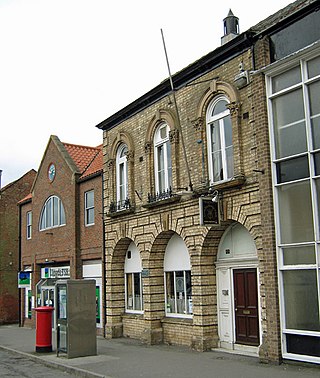
The Hazlitt Theatre and Exchange Studio, also known as the Hazlitt Arts Centre, is a theatre complex in Earl Street in Maidstone, Kent, England. The oldest part of the complex, which is now used as a shopping complex on the ground floor, and as a theatre venue known as the "Exchange Studio" on the first floor, is a Grade II listed building.

The Grand Opera House is a theatre on the corner of Clifford Street and Cumberland Street in York, North Yorkshire, England. The structure, which hosts touring productions of plays, musicals, opera and ballet, as well as one-off performances by comedians, and other theatrical and musical events, is a Grade II listed building.

The Corn Exchange is an events and concert venue located on St Paul's Square in the Castle area of Bedford, Bedfordshire, England. The structure, which was commissioned as a corn exchange, is a Grade II listed building.

The Palace Theatre & Grand Hall Complex is a multi-purpose entertainment arena complex in Green Street, Kilmarnock, Scotland. The structure, which was originally opened as a corn exchange, is a Category A listed building.

The Edinburgh Corn Exchange is an events and concert venue located in New Market Road in Edinburgh, Scotland. The structure, which was commissioned as a corn exchange, is a Category B listed building.

Corn exchanges are distinct buildings which were originally created as a venue for corn merchants to meet and arrange pricing with farmers for the sale of wheat, barley, and other corn crops. The word "corn" in British English denotes all cereal grains, such as wheat and barley. With the repeal of the Corn Laws in 1846, a large number of corn exchanges were built in England, particularly in the corn-growing areas of Eastern England.

The Corn Exchange is a commercial building in the Saturday Market, Beverley, East Riding of Yorkshire, England. The structure, which was commissioned as a corn exchange and is now used as a department store, is a Grade II listed building.

The Corn Exchange is a commercial complex in the High Street, Rochester, Kent, England. The complex, which was commissioned as a corn exchange and is now used as an events venue, is a Grade I listed building.

The Corn Exchange is a commercial building in the Market Place, Devizes, Wiltshire, England. The structure, which was commissioned as a corn exchange and is now used as an events venue, is a Grade II listed building.

The Market House is a commercial building in Church Street in Camborne, Cornwall, England. The structure, which is currently used as a hotel and public house, is a Grade II listed building.

The Corn Exchange is a commercial building in Queen Street, Market Rasen, Lincolnshire, England. The structure, which is used as the offices of a firm of charted surveyors, is a Grade II listed building.

The Corn Exchange is a commercial building in the Market Place, Wallingford, Oxfordshire, England. The structure, which is used as a theatre, is a Grade II listed building.

The Alexandra Theatre is an entertainment complex in Market Street, Newton Abbot, Devon, England. The structure, which was commissioned as a corn exchange and is currently used as a cinema, is a Grade II listed building.

The Corn Exchange is a commercial building in Angel Street, Worcester, Worcestershire, England. The structure, which is currently vacant, is a Grade II listed building.

The Corn Hall is a commercial building in the Market Place, Cirencester, Gloucestershire, England. The structure, which is used as a shopping arcade and community events venue, is a Grade II listed building.

The Corn Exchange is a commercial building in the Market Place, Kettering, Northamptonshire, England. The structure, which was used as a cinema for much of the 20th century, currently accommodates a restaurant.

Westgate Hall is a commercial building in Westgate, Grantham, Lincolnshire, England. The structure, which was last used as a nightclub, is a Grade II listed building.

The Corn Exchange is a commercial building in the Market Place in Barton-upon-Humber, Lincolnshire, England. The structure, which is now used as a private members club, is a Grade II listed building.

The Corn Exchange is a commercial building in the High Street in Ross-on-Wye, Herefordshire, England. The structure, which is now used as a bookshop and as the offices of Ross-on-Wye Town Council, is a Grade II listed building.

The Corn Exchange is a commercial building in Exchange Square in Beccles, Suffolk, England. The structure, which is now used as a branch of Lloyds Bank, is a Grade II listed building.





















